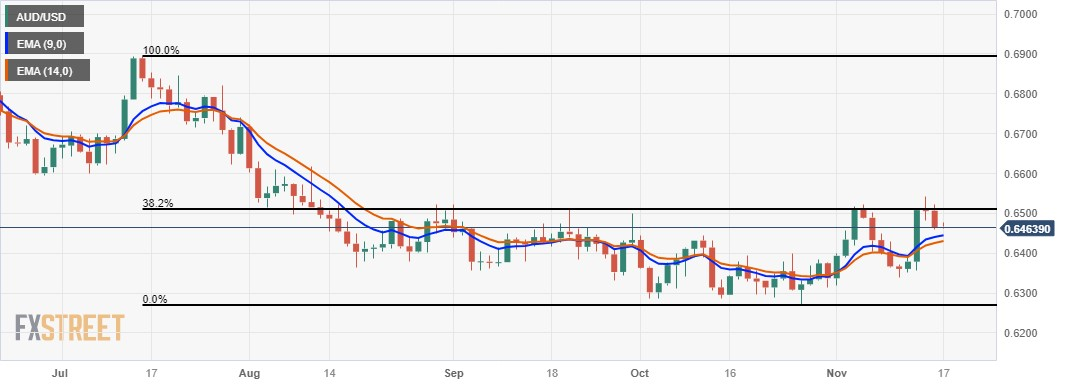- Australian Dollar faces challenges due to risk-off sentiment.
- Australia’s Employment Change report failed to support the AUD.
- US Initial Jobless Claims reached 231K the highest level in nearly three months.
The Australian Dollar (AUD) faces challenges and continues the losses on Friday, despite the downbeat economic data from the United States (US) released on Thursday. The AUD/USD pair's weakness might be attributed to a risk-off sentiment, which could be due to the Federal Reserve's (Fed) uncertainty regarding interest rate trajectory. However, the softer US labor market conditions combined with recent inflation data reinforce the perspective that the Fed is unlikely to raise interest rates further.
Australia’s Dollar (AUD) failed to benefit from an upbeat Aussie jobs report and higher inflation expectations. The seasonally adjusted Employment Change reported an increase in October significantly higher than the market anticipation. However, the majority of the jobs were part-time positions, which somewhat diminished the positive impact of the overall headline.
US Dollar Index (DXY) moves sideways with a negative bias after a previous session characterized by volatility but ultimately favoring the Greenback. Despite weak US economic data and downbeat US bond yields, the US Dollar (USD) managed to recover ground. The yield on the 10-year Treasury note bottomed at 4.43% on Thursday.
US Continuing Jobless Claims for the week ending on November 3 reached the highest level since 2022 at 1.865M from the previous reading of 1.833M. Additionally, Initial Jobless Claims for the week ending on November 10 rose to 231K against the 220K as expected, marking the highest level in nearly three months. However, the Philadelphia Fed Manufacturing Survey reported a figure of -5.9, showing an improvement compared to the previous -9.0 print.
Daily Digest Market Movers: Australian Dollar weakens on risk-off sentiment due to Fed’s uncertainty
- Australia’s seasonally adjusted Employment Change reported an increase of 55K in October, compared with the market anticipation of 20K and 6.7K in the previous month.
- Aussie Unemployment Rate came in at 3.7% in October as expected against the previous figure of 3.6%.
- Australia’s Wage Price Index grew 1.3% as expected compared to the previous reading of 0.8%. The year-over-year data showed an increase of 4.0% more than the anticipated 3.9%.
- RBA Assistant Governor Marion Kohler noted that inflation's decline will likely be more gradual than expected, due to sustained high domestic demand and strong labor and cost pressures, underscoring the necessity for stricter policies to combat persistent inflation.
- The meeting between US President Joe Biden and Chinese President Xi Jinping has resulted in a commitment to stabilize strained bilateral ties and restore some military-to-military communications.
- President Xi expressed the desire for the US to cease arming Taiwan and to support what China terms as the 'peaceful reunification' with Taiwan. Additionally, there is a request for the US to lift unilateral sanctions and create a fair and just environment for Chinese companies.
- China’s House Price Index declined by 0.38% in October compared to the previous decline of 0.1%, indicating a worsening condition in the country's property sector.
- China's Industrial Production (YoY) showed growth at 4.6% in October, a slight increase from the previous 4.5%, contrary to expectations of consistency. Retail Sales year-over-year saw an uptick to 7.6%, surpassing the anticipated 7.0%.
- US Producer Price Index (PPI) took an unexpected turn in October, declining by 0.5% against the anticipated 0.1% increase. The annual rate also witnessed a drop from 2.2% to 1.3%. These figures align with the softer inflation indicated by Tuesday's US Consumer Price Index (CPI) data.
- US Retail Sales declined by 0.1% in October, defying expectations of a steeper slide of 0.3%. Investors' focus shifts to weekly Jobless Claims on Thursday.
- The US Consumer Price Index (CPI) for October showed lower readings than expected, with the annual rate slowing from 3.7% to 3.2%, falling below the consensus forecast of 3.3%. The monthly CPI reduced to 0.0% from 0.4%.
- The US Core CPI rose by 0.2% below the expectations of 0.3%, and the annual rate decreased to 4.0% from 4.1% prior.
Technical Analysis: Australian Dollar holds ground above the 0.6450 major level backed by nine-day EMA
The Australian Dollar trades around the 0.6460 level on Friday, aligned with the immediate major support at 0.6450. Further support may be found at the nine-day Exponential Moving Average (EMA) at 0.6445 and the 14-day EMA at 0.6430. A potential further decline could navigate the pair toward the major support level at 0.6400. On the upside, the AUD/USD pair may encounter immediate resistance at the psychological level of 0.6500. Should it continue its upward movement, the next resistance levels include the 38.2% Fibonacciretracement at 0.6508.
AUD/USD: Daily Chart

Australian Dollar price today
The table below shows the percentage change of Australian Dollar (AUD) against listed major currencies today. Australian Dollar was the weakest against the Japanese Yen.
| USD | EUR | GBP | CAD | AUD | JPY | NZD | CHF |
| USD |
| -0.02% | 0.04% | -0.04% | 0.07% | -0.11% | 0.11% | -0.02% |
| EUR | 0.01% |
| 0.07% | -0.03% | 0.05% | -0.08% | 0.11% | 0.00% |
| GBP | -0.04% | -0.06% |
| -0.10% | 0.01% | -0.15% | 0.06% | -0.05% |
| CAD | 0.03% | 0.06% | 0.09% |
| 0.13% | -0.06% | 0.15% | 0.03% |
| AUD | -0.05% | -0.06% | -0.01% | -0.10% |
| -0.15% | 0.06% | -0.05% |
| JPY | 0.10% | 0.10% | 0.15% | 0.06% | 0.17% |
| 0.20% | 0.08% |
| NZD | -0.14% | -0.13% | -0.06% | -0.15% | -0.06% | -0.21% |
| -0.15% |
| CHF | 0.01% | 0.01% | 0.07% | -0.02% | 0.06% | -0.08% | 0.13% |
|